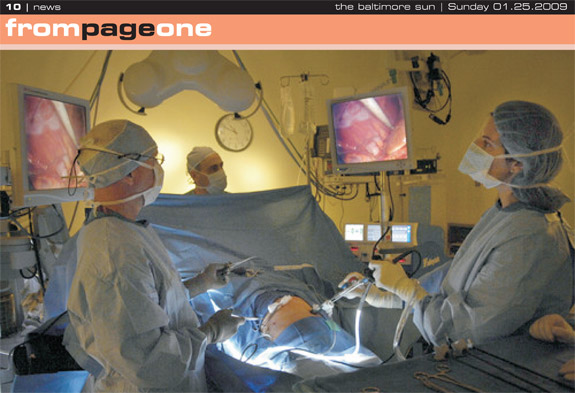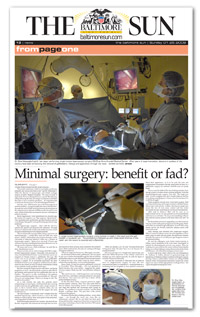Minimal Surgery: Benefit or Fad?
 baltimoresun.com
baltimoresun.com
Minimal surgery becomes more common
Doctors wonder whether benefits justify its use
By Stephanie Desmon | stephanie.desmon@baltsun.com
January 25, 2009
After less than 30 minutes of surgery, Dr. Gina Massoglia removed Caren Eckwerth's gallbladder by squeezing it out through a tiny incision in her belly button. A colleague followed up with three small stitches in the navel, covering the wound with a Band-Aid.
In a week, no one but her doctors will know the 57-year-old Annapolis woman even had surgery.
An operation that once required a six-inch cut under the rib cage and went on, with the spread of laparoscopy, to be a less-invasive surgery involving three or four small slits is now becoming a practically scarless procedure in the hands of a tiny but growing group of surgeons like Massoglia.
After years of experimentation, doctors in pockets of the country have been announcing the removal of gallbladders, kidneys and appendixes through the navel. Some weight-loss surgeries have also been done through a single incision, as have some hysterectomies.
But as this next generation of minimally invasive surgeries becomes more common - and as a handful of surgeons experiment with the truly scarless removal of organs through natural orifices such as the mouth and vagina - some wonder if there is any benefit to the patient beyond the cosmetic and whether that is enough to justify its growing use.
"We need to determine which is in actuality an advance in health care versus a fad that is not," said Dr. Mohamad E. Allaf, the director of laparoscopic and robotic urologic surgery at Johns Hopkins Hospital. "We need to study it rigorously. Not everything that's new is good. The data may end up showing the only advantage is [cosmetics] and that's that. But we have to ask the questions. ... It's important that we don't use 'less invasive' as an advertising mechanism."
Late last year, Allaf became one of the first surgeons to remove a kidney - an organ roughly the size of a human fist - through the navel. While he has performed about a dozen of the surgeries and is pleased with the results, he said it is too early to tell whether this incremental advance will improve patient outcomes.
Before laparoscopy went mainstream two decades ago, the mantra of surgeons was "big surgeons, big incisions." They needed to open up the body, get their hands in and feel everything as they got to work, performing operations large and small.
But laparoscopic surgeries - done with the aid of a camera and special tools placed in the abdomen - brought about a revolution with smaller and smaller incisions, much less pain and shorter recovery time for patients.
"If you told me 20 years ago I'd be taking a pancreas out laparoscopically, I would have told you that you were insane," said Dr. Adrian Park, chief of general surgery at the University of Maryland Medical Center and a pioneer of laparoscopic surgery. "Many of us can recall 15 years ago and more having everything but tomatoes thrown at us, so strong was the resistance to laparoscopy.
"So many said it was a flash in the pan," he said. But in time, "the data bore us out."
There is no data yet on what is being called SILS, single-incision laparoscopic surgery. Massoglia, who practices at Anne Arundel Medical Center, was invited last year to see surgeons in Tampa remove a gallbladder this way. She wasn't sure it was possible to improve upon gallbladder surgery, a simple, 20- to 30-minute procedure she does hundreds of times a year using four small incisions to allow room for the camera as well as various instruments to help retract and take out the gumball-sized organ.
But after seeing the single-incision operation - and being taught how to do it - she decided she wanted to offer SILS to her patients and removed her first gallbladder this way in October. "The goal is to offer something to the patients without compromising the case you normally do," she said. "Here, it's not taking longer. There's no change in risk. The benefit is, it's scarless."
As a side benefit, she said, her patients aren't complaining of as much pain. And if she finds she is having trouble removing the gallbladder with a single incision or port, or she is worried about a patient's safety, she can always make extra incisions and do the surgery the more traditional way.
The SILS surgery is technically more complex than the standard laparoscopy, which involves a cut in the belly button as well as two or three more ports in the abdomen, none larger than 10 millimeters.
When Massoglia uses just one incision, she must fit her flexible, chopsticks-like instruments through that one hole and maneuver them around, a task limited by the confined space. Better instruments, she said, are coming as this type of surgery catches on.
"There are angles it's hard to see," Massoglia conceded.
As she removed Eckwerth's gallbladder, she was aided by the use of stitches threaded through the skin to hold the gallbladder in place as she dislodged it from its spot tucked in behind the liver. The pricks made by those stitches, smaller than needle sticks, won't even be bandaged.
Stacey Slack, 39, had her painful gallbladder removed in November. When Massoglia - who had operated on Slack's hernia a few years earlier - suggested the single-incision surgery, Slack says she "was definitely willing to try it."
"She said it was new. I didn't expect new as in me being one of the first," said Slack, a neonatal intensive care nurse from Bowie. "You can't even tell I had it done. It'll be perfect for bikini season."
At the Cleveland Clinic, surgeons pioneered single-incision kidney removal. They have also used SILS to harvest kidneys from kidney donors for transplantation and hope this method will encourage more people to donate. "The goal here is not only cosmetic," said Dr. Jihad Kaouk, a urologist there. "The goal here is the overall wellness of the patient."
He knows that the idea of taking a kidney - or any other organ - out through the navel may seem like an unnecessary advance. But he said there has been great demand from other surgeons to learn how to perform the procedure, including a class in May that drew 350 instead of the 100 expected.
"There are skeptics, yes," he said. "It comes from a lack of long-term data. We don't have it so far because it's a young procedure."
Not everyone has even bought into laparoscopy yet, Allaf said. While 90 percent of the kidneys removed at Hopkins are done laparoscopically, he said, the figure is more like 30 percent nationally.
Park said the University of Maryland has no plans to move to single-incision surgery for now. He isn't convinced that there is a benefit to it - except perhaps as a marketing tool for hospitals to lure patients concerned about their appearance. As it is, he said, the pain and complications associated with the small ports he uses in a gallbladder surgery are minimal. And the scars are pretty small.
"If you want the battle of the nice-looking tummies, I can line up a bunch of slides of nice-looking tummies" from the standard laparoscopic surgery, Park said. "The single port stuff - it's low-hanging fruit, and it maybe helps us feel like we're doing something new. I have yet to be convinced it's worth the struggle."
When surgeons moved away from open surgery, Park said, they lost having a full range of motion with their hands, elbows and wrists as they worked. Moving to a single port means the loss of even more control and fine motor movement, he said, something he worries will hurt patients.
Allaf said he believes SILS will be seen as an improvement. So far, he said, patients use fewer painkillers and return to work faster. "If you can do something with one hole and do it just as good as with more, then why not?" he said.
He likened the advance to upgrading your television set. You can watch a television program on an old grainy black-and-white set and still laugh at the jokes, he said. Still, many people opt for the 50-inch, full-color plasma screen with surround sound.
Allaf, though, isn't satisfied with single-port surgery. When it comes to kidney cancer, he said, regardless of how many large or small cuts are made, the procedure remains basically the same as it was 100 years ago: Surgeons remove the diseased kidney.
He and his colleagues want future improvements in kidney cancer treatment to be even more meaningful to patients by eliminating the need for any surgery. They are working on ways to freeze the cancer without removing the kidney, as well as looking at using ultrasound and electricity to kill tumors - all without increasing recurrence rates.
A short walk from Allaf's office is the one belonging to Dr. Anthony N. Kalloo, director of gastroenterology and hepatology at Hopkins. Kalloo has been working for years to develop what he and his fellow doctors are calling NOTES (natural orifice transluminal endoscopic surgery) in which organs are removed through patients' existing orifices - the vagina being the most popular so far.
"What if you took this one step further," he said. "Instead of having small incisions, having no incisions."
When he first talked about it, he was told it was malpractice. "You're going to kill patients," critics said.
This type of procedure has probably been done about 300 times, Kalloo said, mostly outside the United States. Gallbladders, kidneys, appendixes have been taken out, mostly by cutting a hole in the vagina wall and then sewing it back up once the organ is out.
The surgeries have not been pure NOTES - they have been assisted by a camera inserted into a small incision in the belly button. The experimental procedure, he said, is still one to two years away from mainstream use.
The idea, for now, makes doctors nervous. Said Allaf: "NOTES scares me." He and others worry about the complications that could come with making holes in the bowel or in the vaginal wall to remove organs that can be easily taken out laparoscopically.
At Anne Arundel Medical Center, Massoglia wraps up her third gallbladder surgery of the morning - two single-incision operations and one using four ports. She is still figuring out which patients make the best candidates for her new technique. She has started with thinner patients, whose anatomies tend to make surgeries less difficult, and has slowly offered it to more.
What she is doing still startles some of her colleagues. She tells of one patient - a 21-year-old bartender with a belly button ring - whose scar was essentially invisible soon after Massoglia removed her gallbladder.
When the woman went to see her primary care physician, Massoglia said, "he didn't believe that she'd had it done."
Dr. Gina Massoglia (right), has begun performing single incision laparoscopic surgery (SILS) at Anne Arundel Medical Center. After years of experimentation, doctors in pockets of the country have been announcing the removal of gallbladders, kidneys and appendixes through the navel. Baltimore sun photos: amy davis

In The News
Read about Dr. Massoglia in the Sun paper as the areas first surgeon to perform Single Incision Laparoscopic Surgery. More Info






